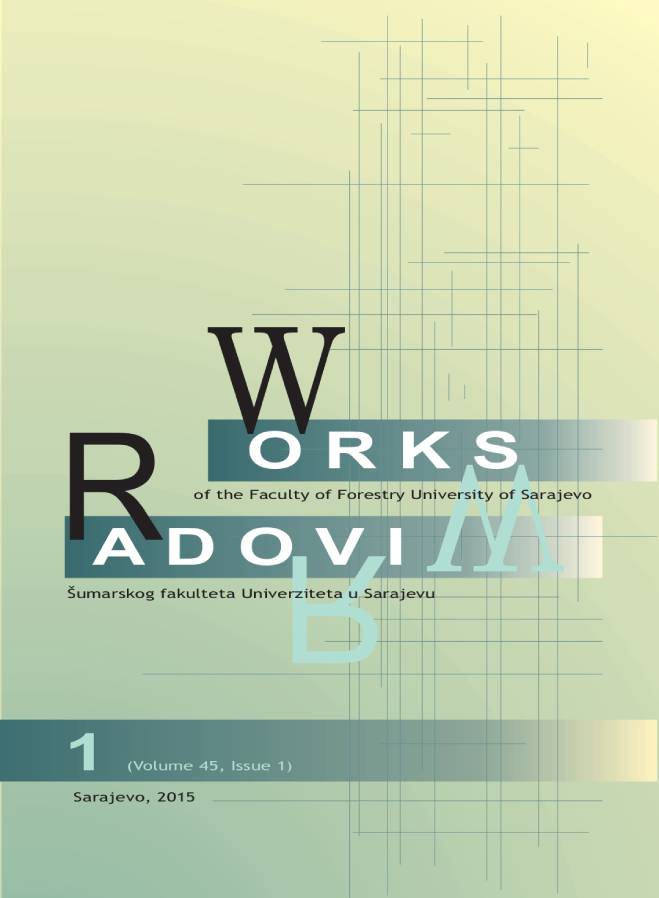DETECTION OF DECAY IN INJURED TREES OF SILVER FIR USING THE METHOD OF TOMOGRAPHY
DOI:
https://doi.org/10.54652/rsf.2015.v45.i1.90Keywords:
Silver Fir, Abies alba Mill, stem injuries, fungi,, decay, tomography, ARBOTOM®Abstract
UDK: 630*44:632.25(234.422 Igman)
Silver Fir in Bosnia and Herzegovina is the important coniferous species of trees in term of forestry and biodiversity. Numerous harmful factors have the impact to its health and vitality. One of them is different damages of standing trees by machinery. These injuries represent suitable entering openings for microorganisms which afterwards cause decay of the wood. Wood affected by this process has a decreased quality or it becomes completely unusable. Infection and development of decay are in correlation with the size of the injuries and its position on the tree. In recent times the methods of analysis of decay based on the flow of electric energy or sound through the wood were developed. One of these methods is the sound tomography which gives us the possibility to review the condition of the tree without the need to cut it or damage it significantly. It is performed by the device called tomograph. In this paper, by the method of tomography, the presence of signs of decay of wood on injured trees of Silver Fir was identified.
Downloads
References
DOLEŽAL, B. (1984): Štete u šumi izazvane primjenom mehanizacije. Dokumentacija za tehniku i tehnologiju u šumarstvu 81, 1-47.
FICKLIN, R. L., DWYER, J. P., CUTTER, B. E., DRAPER, T. (1997): Residual tree demage during selection cuts using two skidding systems in the Missouri Ozarks. Proceedings of the 11th Central Hardwood forest conference; 1997 March 23-26; Columbia, MO, 36-46.
GILBERT, A. E., SMILEY, T. (2004): Picus sonic tomography for the quantification of decay in white oak (Quercus alba) and hickory (Carya spp.). Journal of Arboriculture 30 (5), 277-281.
JOURGHOLAMI, M., MAJNOUNIAN, B. (2011): Residual stand damage following ground-based skidding operation (Case study: Kheyrud Forest). Proceedings of the 44th International Symposium on Forestry Mechanisation: “Pushing the Boundaries with Research and Innovation in Forest Engineering”, October 9-13, 2011 in Vienna, Austria, 1-11.
KARADŽIĆ, D. (2008): Najčešće gljive prouzrokovači bolesti u prirodnim sastojinama smrče i jele. Šumarstvo, vol. 60, br. 3, 83 – 89.
KRPAN, A. P. B., PETREŠ, S., IVANOVIĆ, Ž. (1993): Neke fizičke štete u sastojini, posljedice i zaštita. Glasnik za šumske pokuse posebno izdanje 4, 271-280.
KULUŠIĆ, B. (1990): Karakteristike šumskih terena kao indikatori izbora tehnologije privlačenja drveta. Šumarski list (114) 11-12, 463-473.
LI, L., ZIPING, W., LIHAI, W., BRUCE, A. R. (2009): Acoustic tomography in relation to 2D ultrasonic velocity and hardness mappings. Proceedings of the 16th nondestructive evaluation of wood symposium, October 12-14, 2009 in Beijing, China, 28-35.
MATIĆ, V. (1977): Metodika izrade šumskoprivrednih osnova za šume u društvenoj svojini na području SR BiH. Šumarski fakultet i Institut za šumarstvo u Sarajevu, posebno izdanje broj 12, 1-176.
MONTGOMERY, C. D. (2005): Design of analysis of experiments. John Wiley&Sons, Inc.
NICOLOTTI, G., SOCCO, L. V., MARTINS, R., GODIO, A., SAMBUELLI, L. (2003): Application and comparison of three tomographic techniques for detection of decay in trees. Journal of Arboriculture 29(2), 66-78.
PORŠINSKY, T., OŽURA, M. (2006): Damage to standing trees in timber forwarding. Nova mehanizacija šumarstva 27, 41–49.
SCHULTZ, H. (1973): Consequences of the extraction demage on young beech and other hradwoods. Holz-Forschung, 27,42-47.
SMITH, A.C, MILLER, G.W., SCHULER, T.M. (1994): Closure of logging wounds after 10 years. USDA Forest Service - Northeastern Forest Experiment Station, Research Paper, NE-692, 1-10.
STEFANOVIĆ, V., BEUS, V., BURLICA, Č., DIZDAREVIĆ, H., VUKOREP, I. (1983): Ekološko – vegetacijska rejonizacija Bosne i Hercegovine. Šumarski fakultet Univerziteta u Sarajevu, Posebno izdanje br.17, 1-51.
TREŠTIĆ, T., USČUPLIĆ, M., MUJEZINOVIĆ, O., MEMIŠEVIĆ, M. (2003): Armillaria gljive u centralnoj Bosni. Radovi Šumarskog fakulteta Univerziteta u Sarajevu, No. 1, 41-46.
USČUPLIĆ M., DAUTBAŠIĆ M., TREŠTIĆ T., SELMAN E., MUJEZINOVIĆ O., NIŠIĆ T. I JOKANOVIĆ B. (2007): Bolesti i štetnici obične jele (Abies alba Mill.) u Bosni i Hercegovini. Društvo za zaštitu bilja u Bosni i Hercegovini, Sarajevo, 1-114.
USČUPLIĆ, M., DAUTBAŠIĆ, M. (1998): Bolesti i štetočine koje ugrožavaju šumske ekosisteme u Bosni i Hercegovini. Radovi Šumarskog fakulteta Univerziteta u Sarajevu, No. 1, 19-26.
VASAITIS, R., LYGIS, V., VASAILIAUSKAITE, I., VASILIAUSKAS, A. (2012): Wound occlusion and decay in Picea abies stems. European Journal of Forest Research, Volume 131, Issue 4 , 1211-1216.
VULETIĆ, D. (2001): Utjecaj mehaničkog ozljeđivanja stabala na kakvoću sortimenata hrasta lužnjaka (Quercus robur, L.). Radovi šumarskog instituta Jastrebarsko, 36 (1), 15–32.
WARGO, P. M. (1983): How stress predisponses trees to attack Armillaria mellea - A hypothesis. Proceedings of the Sixth Interational Conference on Root and But Rots of Forest Trees, Melbourne, 115-121.
ZAHIROVIĆ, K. (2012): Uticaj štetnih agenasa na iskorištenje drvne mase smrče. Završni rad II ciklusa. Šumarski fakultet Univerziteta u Sarajevu, 1-56.






















